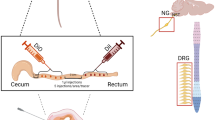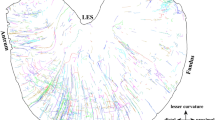Abstract.
Transneuronal tracing with pseudorabies virus (PRV) was used to identify sites in the central nervous system involved in the neural control of colon function. PRV-immunoreactive (IR) cells were primarily localized to the caudal lumbosacral (L6–S1) and caudal thoracic-rostral lumbar (T13–L1) spinal segments with the distribution varying according to survival time (72–96 h). In the lumbosacral spinal cord at all time points examined, significantly (P≤0.005) greater numbers of PRV-IR cells were present in the region of the sacral parasympathetic nucleus (SPN) of the S1 spinal segment compared to that of the L6 segment. These studies also revealed morphologically distinct cell types with a differential distribution (probably interneurons and preganglionic parasympathetic neurons) in the region of the SPN in the L6–S1 spinal segments following colon inoculation. PRV-labeled neurons were located at various levels of the neuraxis and at many sites had a distribution similar to that following injection of virus to other urogenital organs. However, some unique sites in the dorsal motor nucleus of the vagus, nucleus of the solitary tract, nucleus ambiguus and area postrema were also identified. To determine if labeling in these caudal medullary sites was mediated by spinal or vagal pathways, the colon was inoculated with PRV in animals with a complete spinal cord (T8) transection (5–7 days prior). Following spinal transection, PRV-infected cells were detected in the same caudal medullary regions; however, labeling in other regions (e.g., Barrington's nucleus) was eliminated or significantly reduced. These studies have yielded several novel observations concerning the central neural control of colonic function: (1) the preganglionic efferent and primary afferent innervation of the colon arises primarily from the S1 spinal segment; (2) the distribution of PRV-infected neurons in the central nervous system following colon inoculation was similar to that following PRV inoculation of other urogenital organs; (3) Barrington's nucleus, which has been identified previously as the pontine micturition center, may have a role in colonic function; and (4) PRV infection in Barrington's nucleus following colon inoculation is mediated by bulbospinal pathways whereas labeling in caudal medullary regions is mediated, at least in part, by vagal pathways.
Similar content being viewed by others
Author information
Authors and Affiliations
Additional information
Electronic Publication
Rights and permissions
About this article
Cite this article
Vizzard, M., Brisson, M. & de Groat, W. Transneuronal labeling of neurons in the adult rat central nervous system following inoculation of pseudorabies virus into the colon. Cell Tissue Res 299, 9–26 (2000). https://doi.org/10.1007/s004419900128
Received:
Accepted:
Issue Date:
DOI: https://doi.org/10.1007/s004419900128




